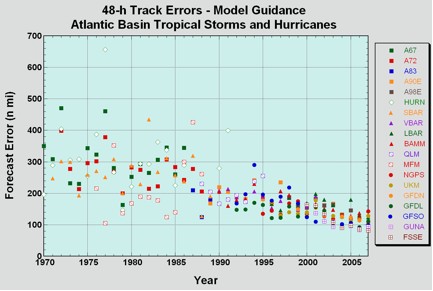The U.S. National Hurricane Center (NHC) evaluates hurricane forecast model accuracy every year by evaluating forecast errors. Track forecast errors are defined as the difference between the predicted and actual positions of the storm center at a given lead time (e.g. 24 hours in advance). The NHC publishes this information on their website. Below is a graph showing the average 48-hour Atlantic Basin tropical storm and hurricane track errors from various models for the period from 1970 to 2007:
During this period, model track error decreased significantly, which was largely responsible for improved official track forecasts made at the National Hurricane Center (NHC), as shown in following graph:
The accuracy of hurricane forecast models can vary significantly from storm to storm. For some storms, the factors affecting the hurricane track are relatively straightforward, and the models are not only accurate but they produce similar forecasts, while for other storms, the factors affecting the hurricane track and more complex, and different models produce very different forecasts, as shown in the following figures:
Both forecast model and NHC official hurricane intensity accuracy has not shown significant improvement over time, with both still attempting to produce accurate intensity forecasts:
Every year, improvements are made to the hurricane forecast models, and large efforts are currently underway to research ways to improve dynamical hurricane model forecasts, including NOAA’s Hurricane Forecast Improvement Project. This project focuses on increasing model resolution; improving representation of modeled physical processes both within the atmosphere and at the air-sea interface where the hurricane interacts with ocean; verifying model output with observations of atmospheric variables; and improving data assimilation techniques within the model. While these efforts may also continue to improve track forecasts, they should prove particularly useful for the much more complicated problem of predicting hurricane intensity, which unlike track, involves horizontal scales both larger than a hurricane and smaller than a raindrop. Nevertheless, scientists are aware that there may be a predictability limit, at which point no amount of model improvements will improve the forecast, but it is not known where that predictability limit is. Even with a “perfect” model that captures all of the relevant physics, uncertainties in the initial condition limit the model’s ability to create a perfect forecast, especially at longer lead times (> 5 days). It should be noted, however, that longer-term hurricane activity may be predictable even if the details of each individual hurricane’s track and intensity become unpredictable. |



